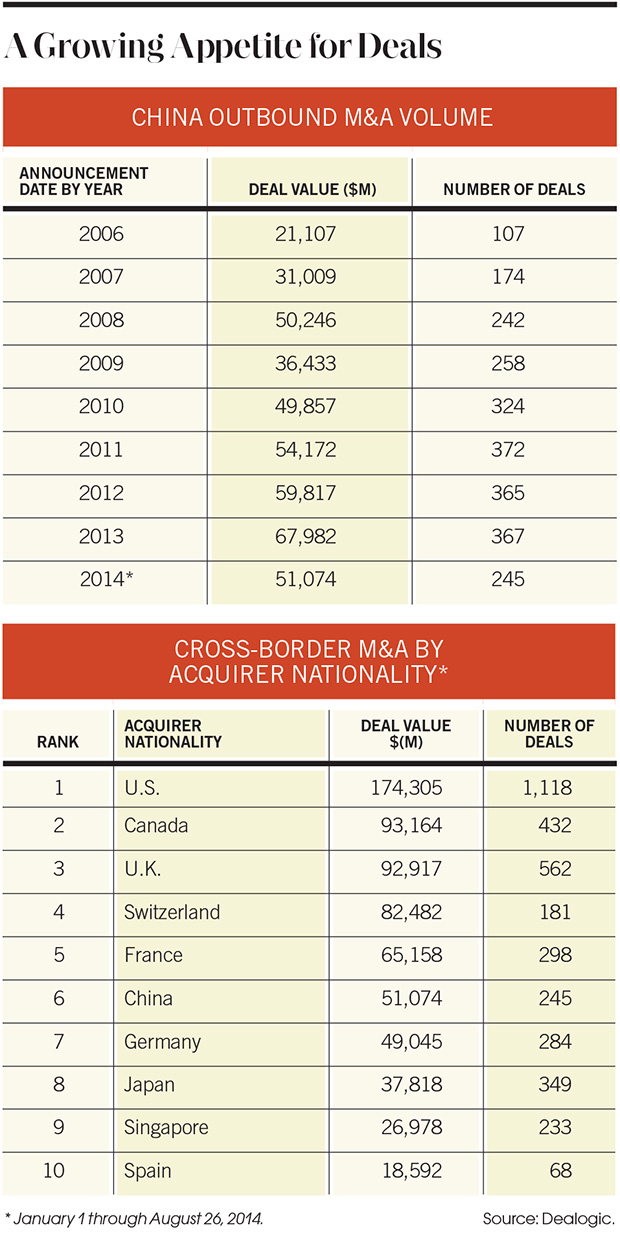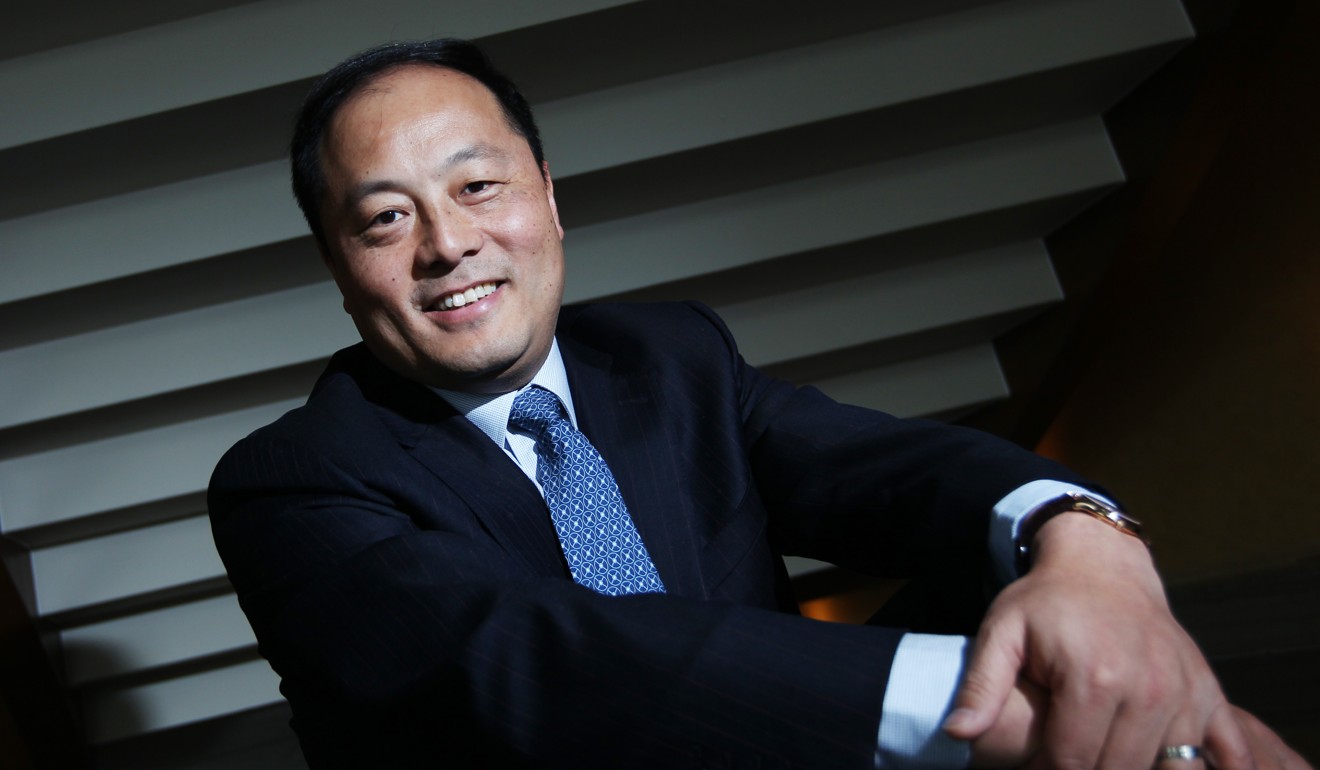
������̬
Institutional Investor��Chinese Companies Are the New Force in Global M&A
AddTime��2014-08-28
In April, John Zhao learned through investment bankers that London-based Pizza Express (Restaurants) was for sale. Zhao, CEO of Beijing-based private equity firm Hony Capital, loved to go out for deep-dish pizza while he was studying for his MBA at Northwestern University��s Kellogg School of Management in the mid-��90s, and he felt there was money to be made in bringing the U.K.��s largest pizza chain to China. After all, the country��s burgeoning middle class had developed a healthy appetite for Western food, making China the biggest overseas market for Yum! Brands�� Pizza Hut chain.
Within a week of hearing the news, Zhao was on a plane to meet the top executives of Cinven, the British buyout firm that owned Pizza Express. In the ensuing weeks his firm outbid three rivals, including Chinese financial conglomerate CITIC Group, and took over the restaurant chain in June. The ?900 million ($1.54 billion) investment was the largest ever for $7 billion-in-assets Hony Capital, a ten-year-old firm backed by Legend Holdings Corp., parent company of computer maker Lenovo Group.
��Pizza Express may have more than 50 years of history and more than 500 stores in the U.K., but it entered Hong Kong and Shanghai just a few years ago,�� Zhao says. ��It only has 12 stores in Hong Kong and nine stores in Shanghai. I see many new stores opening in China in the coming few years. We also see many Pizza Express stores opening in emerging markets all over the world in the coming years.��
The growing appetite of Chinese consumers has propelled the country��s companies to the top ranks of the global league tables for mergers and acquisitions. In 2013, Chinese firms completed 367 overseas deals worth a total of $68 billion, ranking second globally behind U.S. firms, which completed 1,693 deals worth $200 billion, according to data provider Dealogic. Corporate China��s demand for overseas assets continued to grow this year, reaching $51.1 billion as of August 26, but that was good for only sixth place in the M&A league tables, as deal making picked up in Canada, the U.K., Switzerland and France. Chinese companies are acquiring a wide range of assets, however, ranging from minerals, energy and natural resources to agriculture and technology companies, and consumer brands such as Pizza Express.

��We are seeing Chinese companies that a few years ago were just domestic players becoming global players,�� says George Davidson, HSBC Holdings�� Hong Kong�Cbased vice chairman of Asia-Pacific M&A. ��We are seeing not only state-owned enterprises but, increasingly, Chinese private enterprises seeking ever-bigger acquisitions globally.��
Lenovo is a prime example. Earlier this year the technology company agreed to acquire Google��s Motorola Mobility business for $2.9 billion and IBM Corp.��s x86 server business for $2.3 billion. Both deals are waiting for regulatory approval. If they go through, the purchases would make Beijing- and Morrisville, North Carolina�C based Lenovo the world��s third-largest smartphone maker and the leading supplier of general-purpose servers. They would also eclipse any previous tech takeover by a Chinese company, including the $1.75 billion that Lenovo shelled out for IBM��s struggling laptop business in 2005.
Other major deals this year include the $7 billion buyout of Glencore��s Las Bambas copper mine in Peru by an arm of China Minmetals Corp. and the $1.5 billion purchase of a 51 percent stake in grain producer Noble Agri, a unit of Hong Kong commodities company Noble Group, by China National Cereals, Oils and Foodstuffs Corp. and Hopu Investment Management Co., a private equity firm led by former Goldman Sachs Group rainmaker Fang Fenglei.
The Pizza Express deal marked another milestone in that it was the largest offshore acquisition ever by a Chinese private equity firm; the sector has traditionally focused on mainland targets.
Li Zhiyong, deputy secretary general of the Beijing-based China Venture Capital and Private Equity Association, says many of the organization��s 1,000 or so members are looking to emulate Hony Capital��s bold move. ��Many of our members have zero experience making acquisitions overseas, but they are now all looking offshore for deals,�� says Li, whose group operates under the supervision of the National Development and Reform Commission (NDRC), China��s economic planning ministry. ��The Chinese government is pushing renminbi internationalization. That means not only Chinese corporates will be aggressively seeking acquisitions overseas; it means Chinese private equity funds also will be going offshore.��
When China began its economic reforms in the early 1980s, the country was cash-strapped and relied heavily on foreign direct investment to drive growth. Companies from the U.S., Europe and developed Asia poured in billions of dollars to establish factories, helping China become the world��s preeminent manufacturing hub by the late 1990s, especially for labor-intensive products. The economy boomed, with growth averaging more than 10 percent a year for the past 30 years.
But the country can��t continue to thrive by being a low-end producer. As Chinese companies mature, they are seeking to move higher up the value chain. The fastest way to achieve that goal, says HSBC��s Davidson, is through offshore investments and acquisitions �� buying resources, technology, brands and technical expertise.
Direct overseas investment by Chinese entities hit an all-time high of $90 billion in 2013, with more than two thirds of the total coming in the form of corporate acquisitions of foreign assets. That represents more than 33-fold growth over 2002, when China first entered the World Trade Organization, and triple the volume of 2010.
That number seems certain to grow. China��s $9.4 trillion economy represents 12 percent of global output, yet the country accounts for only 6 percent of the world��s total $1.46 trillion in overseas direct investments, according to a recent HSBC research report, �� Riding China��s Riding Investment Wave.�� China has ample resources for a spending spree: It owns the world��s biggest pool of foreign exchange reserves, topping $3.95 billion as of July 1.
��China��s outbound investment could easily double,�� says Peter Sullivan, head of equity strategy for Europe at HSBC and a co-author of the report. ��We would be very, very surprised if it stops here.��
In other words, China may someday dominate the M&A league tables just as the U.S. does today. That day is still some ways off, however. According to Dealogic, U.S. companies spent more than $1.6 trillion in the past decade, or an average of $183 billion annually, on offshore M&A. Chinese companies, by comparison, spent only $383 billion in the past decade, or an average of $42 billion a year.
President Xi Jinping and Premier Li Keqiang are actively encouraging Chinese enterprises to go offshore. In May the NDRC began to liberalize its approval process for offshore acquisitions: Those that fall below $1 billion no longer need regulatory approval.
��For the smaller deals all you need to do from now on is to file your acquisition with the commission,�� says Samson Lo, Hong Kong�Cbased head of greater China M&A at UBS. ��You would think this would accelerate more outbound M&A.��
The new guidelines will help streamline China��s regulatory process, which can involve multiple agencies and hold up a deal for months, scaring off potential sellers of foreign assets. ��Many European private equity funds that we deal with, for instance, want certainty that regulatory approval is forthcoming before they are even willing to actively engage with potential Chinese buyers,�� Lo says.
The new reforms will be particularly helpful to private enterprises, many of which do not have the financial firepower of their state-owned counterparts. The reforms are part of the new leadership��s efforts to open up the economy, including large portions of the state-owned-enterprise sector, to ownership by private entities.
Under the leadership of Xi and Li, who took up their posts in early 2013, the government has become more aggressive in acting on behalf of Chinese enterprises, using an antitrust law that favors Chinese corporations in their quest for global resources. Swiss-based mining and metals groups Glencore International and Xstrata had to get clearance from a number of global antitrust regulators before they were allowed to merge in May 2013. China��s Ministry of Commerce said it would endorse the merger only if Glencore sold its $5.2 billion Las Bambas copper mine. Although Chinese regulators never said the asset had to be sold to a Chinese buyer, the condition they set in effect laid the path for various Chinese companies to seek a buyout of Las Bambas. On June 30 a consortium led by Hong Kong�Clisted MMG, which is majority-owned by China Minmetals, the largest state-owned metals conglomerate, beat out three rivals, including another Chinese consortium, to acquire Las Bambas. The deal was the largest offshore mineral acquisition by a Chinese buyer.
��The clear indication under the new leadership is that major offshore acquisitions will continue to happen,�� says John Tivey, Hong Kong�Cbased global head of mining and metals at law firm White & Case, which advised MMG on the transaction. ��This was a $7 billion deal, the biggest that occurred so far under the new government. This was a China Inc.�Cbacked deal.��
The Peruvian copper mine, due to start production in 2015, has the capacity to produce 400,000 metric tons of copper annually, which would make it one of the world��s largest. ��The acquisition of Las Bambas is a proud and significant milestone for MMG, delivering on our growth strategy and objective to be a top three midtier mining company,�� says MMG��s CEO, Andrew Michelmore. The Melbourne-based executive is a mining industry veteran who came to MMG in 2009 after running Australia��s Oz Minerals. He leads seven other senior executives, including five Australians, a Brazilian and a Chinese, at MMG.
��The Chinese are becoming increasingly sophisticated,�� notes Tivey. ��It is now more common for their M&A teams to comprise Chinese nationals who have trained and worked abroad and are very experienced in cross-border transactions. In the case of MMG, this is supplemented by a very experienced team of Australian-based mining executives.��
China��s appetite for natural resources is well known. China National Offshore Oil Corp. (CNOOC) bought Canadian oil and gas producer Nexen for $15.1 billion last year, the largest-ever foreign acquisition by a Chinese entity. Yet 2013 marked the first time that nonresource deals accounted for more than half of China��s overseas acquisitions, with 56 percent of the transactions coming in sectors such as technology, agriculture, real estate and finance.
Meat packer Shuanghui International Holdings paid $4.7 billion for U.S.-based Smithfield Foods, the first multibillion-dollar acquisition by a Chinese company in the food sector. Few expect it to be the last. ��Food safety is a major issue in China,�� says Yan Xuan, Shanghai-based president of China for consumer research firm Nielsen. ��So if a Chinese enterprise can buy a well-known global brand, it will help improve Chinese consumer trust and confidence.��
Yan predicts that nonresource deals will continue to grow, identifying autos, consumer goods, travel and tourism, finance and luxury brands as some of the most promising sectors.
Three years ago Chinese automaker Zhejiang Geely Holding Group Co. made headlines by acquiring Swedish automaker Volvo from Ford Motor Co. for $1.8 billion. ��Volvo continues to be a well-recognized global auto brand under Chinese ownership,�� Yan says. ��Volvo, in fact, has gained market share in China since it became Chinese-owned.�� Volvo reported a 1.4 percent rise in sales last year as a 45.6 percent jump in China offset a decline in the U.S. The performance helped the company return to the black with a net profit of Skr960 million ($148 million) in 2013, compared with a loss of Skr542 million in 2012.
Yan believes a global brand in the high-end luxury products sector could be one of China Inc.��s next targets. Although Chinese companies have developed luxury brands at home, such as Li Ning sports shoes and ROMASTER men��s suits, few have made an international impact. ��It is only a matter of time before a major Chinese company will buy a premium consumer brand, particularly in the luxury area,�� Yan says. ��Chinese enterprises already have created China-owned luxury brands, but there is a vacancy in the global luxury brand space.��
China��s growing global ambitions may run into headwinds, though, as its companies clash with foreign rivals. Fosun Group, a Shanghai-based conglomerate that models its growth on the lines of Warren Buffett��s Berkshire Hathaway, in August gave up its battle to acquire French resort operator Club M��diterran��e. Fosun and its partner, French private equity firm Ardian, together own 18.5 percent of Club Med and had the support of management for their �17.50 ($23.28)-a-share bid, but rival Investindustrial, a private equity fund run by Italian industrialist Andrea Bonomi, won the support of the company��s board for its �21 offer.
Notwithstanding the failure of Fosun��s bid, Chinese companies are likely to pursue more deals in the leisure sector because of the rise of Chinese tourism, says Nielsen��s Yan. More than 98 million Chinese tourists traveled abroad in 2013, spending a total of $129 billion, according to the China National Tourism Administration. ��China already is No. 1 in the outbound travel market in the world, and spending is also rising,�� notes Yan. ��So if a Chinese enterprise can cater to the needs of Chinese tourists overseas, wherever they may be, that is capturing the total value chain.��
Chinese entities have plenty of financial resources to draw on to fuel their overseas ambitions. The China Development Bank, the government��s main policy-driven lender, has funded hundreds of outbound investments. From 2009 through 2013 the bank lent a total of 2.68 trillion yuan ($436 billion) to Chinese enterprises for investments at home and abroad. The CDB doesn��t break out loans for offshore investments, but analysts estimate that about a third of that lending was used overseas, particularly in support of acquisitions.
��Chinese companies could potentially have more financial firepower than international rivals in today��s environment,�� says Christopher Chua, head of China M&A at Credit Suisse. ��In circumstances where national interests are concerned, state-owned enterprises could seek competitive financing from Chinese banks and Chinese policy lenders, whereas many of their international rivals may not be able to get financing on similarly competitive terms.��
The CDB played a key role in the financing of CNOOC��s acquisition of Nexen. The bank provided only $320 million in loans, but its presence helped CNOOC negotiate good terms on a $6 billion bridge loan from a consortium of 19 commercial lenders, which included China��s Big Four banks and a number of global lenders, such as Citigroup.
Companies are beginning to turn to the global capital markets as well. Hony Capital tapped the high-yield market to finance its acquisition of Pizza Express, making it the largest cross-border leveraged buyout by a Chinese firm. After completing the purchase in July, Pizza Express sold ?410 million of seven-year secured bonds at a leverage ratio of 6.5 times pledged shares of Pizza Express and ?200 million of unsecured eight-year notes. The secured bonds were rated B+ and B2 by Standard & Poor��s and Moody��s Investors Service, respectively, and carried a coupon of 6.625 percent; the unsecured notes were rated CCC+ and Caa1, and carried a coupon of 8.625 percent. The financing was one of the biggest ever by a financial sponsor in the sterling high-yield market, according to J.P. Morgan, which advised Hony and acted as a book runner on the bond issue.
��Leveraged finance requires a certain level of sophistication for the buyer to work with banks,�� says Lian Lian, Hong Kong�Cbased co-head of North Asia M&A at J.P. Morgan. ��Hony Capital is one of those sophisticated buyers.��
The growing savvy of Chinese firms is putting pressure on Chinese banks to increase their competitiveness. Industrial and Commercial Bank of China, the world��s largest bank by assets and one of the leading financiers of offshore acquisitions, has been making purchases of its own to expand its global reach and strengthen its capabilities.
��In the past 30 years of market opening and reforms, China already has established a multifaceted, multilayered open economy that continues to gain strength and maturity,�� ICBC chairman Jiang Jianqing said in a May 2013 speech to investors. ��Such an economy must have a financial system that has global reach, with its own corps of multinational corporations as well as multinational banks.��
In the past seven years, the bank has spent $7.1 billion on a dozen offshore investments and acquisitions, chief among them the $4.7 billion purchase of a 20 percent stake in Standard Bank of South Africa in 2008. ICBC has gone on to acquire a number of Standard Bank subsidiaries, paying $640 million for the bank��s Argentinean retail unit in 2012 and reaching an agreement earlier this year to acquire 60 percent of Standard��s London-based global markets business for $770 million.
��They did a good job with the Standard Bank investment,�� says May Yan, Hong Kong�Cbased China banking analyst at Barclays Capital. ��Though they only own 20 percent of the group, they acquired and integrated various portions of Standard Bank in various parts of the world.��
ICBC began making acquisitions in Hong Kong in 2000, when it bought a small lender, Union Bank of Hong Kong. It ventured further afield in December 2006, when it paid $22 million to buy 90 percent of Bank Halim of Indonesia. ICBC acquired Thailand��s ACL Bank for $550 million in 2010, and in 2012 it paid $140 million for the U.S. subsidiary of Hong Kong�Cbased Bank of East Asia. The Chinese giant now has 331 branches in 40 offshore markets, but that pales in comparison with its nearly 17,000 branches on the mainland.
��The Big Five state banks, including ICBC, collectively derive only about 6 percent of their revenues from overseas,�� chairman Jiang said in his speech. ��We still have a long ways to go to become truly international banks here in China.��
Like ICBC, most Chinese companies took their first steps abroad close to home, in Southeast Asia and Central Asia. They then turned their sights on natural-resource assets in Africa and Latin America. Increasingly, however, Chinese buyers are looking to developed markets such as the U.S., Canada, Europe and Australia. As of the end of 2013, Chinese companies had invested a total of $44.6 billion in 29 companies in North America, $17 billion in six companies in Europe and $15.2 billion in 11 companies in Australia, according to Dealogic. The U.S. accounted for only $9.1 billion of the North American total, with Canada making up the rest.
In the past, political and regulatory barriers have stymied Chinese companies in the U.S., most notably when political opposition thwarted CNOOC��s $18.5 billion bid for Unocal Corp. in 2005, allowing Chevron Corp. to snap up the oil producer. But Chinese companies are proving increasingly adept at getting around such hurdles and winning approval from the Committee on Foreign Investment in the United States, or CFIUS, an interagency committee that reviews foreign takeover bids.
In 2012, China Petrochemical Corp., also known as Sinopec, cleared U.S. regulatory requirements to acquire various U.S. shale oil fields from Devon Energy Corp. for $2.5 billion. The deal was a sweet victory for Sinopec chairman Fu Chengyu, who was chairman and CEO of CNOOC when it made its abortive bid for Unocal.
��Navigating foreign regulatory approval processes is part and parcel of China outbound deals,�� says Credit Suisse��s Chua, whose firm advised Sinopec on the purchase of the Devon Energy assets. ��But I do not see them as obstacles that cannot be overcome. Chinese companies have generally been successful in obtaining approvals from international regulatory authorities.��
Chinese companies are hiring lobbyists on Capitol Hill to engage members of Congress �� and hiring lawyers for litigation when necessary. Ralls Corp., a Delaware-based subsidiary of Chinese industrial conglomerate SANY Group Co., sued the Obama administration for blocking its $6 million acquisition of wind farms in Oregon on national security grounds. (The farms are near a naval weapons training facility.) In July a federal appeals court sided with Ralls, ruling that the administration had violated the company��s rights by nullifying the purchase.
��We��re pleasantly surprised that a U.S. court would side with a Chinese company on this national security issue,�� says the China Venture Capital and Private Equity Association��s Li. ��This decision gives Chinese investors more confidence and will boost our willingness to invest in the United States.��
The decision has encouraged Li and his association members to proceed with their plan to invest as much as $50 million in the California Green Tech Park, an environmentally focused industrial park in Silicon Valley. The park will serve as an incubator for green technology and a gateway for Chinese M&A in the sector, Li says. ��Environmental technology is not defense-related and should be a safe area for Chinese companies to invest, incubate technology and even seek acquisitions in,�� says Henry Yin, a retired Silicon Valley entrepreneur who is leading efforts to develop the park.
Chinese companies are eager to license or buy technology and acquire companies that they can use to help clean up China��s polluted environment, Li says. The Chinese government has earmarked more than $650 billion through 2015 for environmental cleanup of its cities.
Despite the huge potential for M&A that the U.S. offers, the Chinese government will be wary of potential political repercussions, says Guan Anping, an adviser to the Ministry of Commerce. ��The Chinese government saw how the U.S. froze Russian assets of various sorts after the fallout from the Ukraine crisis,�� Guan says. ��The government encourages Chinese enterprises to invest offshore, but one nation the government will be cautious on is the U.S. The last thing the Chinese government wants is for the U.S. assets of Chinese enterprises to be frozen or caught up in a potential conflict between the two nations in the future.��
The U.S. isn��t the only country that is wary about selling sensitive technology to the Chinese. So are European nations, says Andr�� Loesekrug-Pietri, managing partner of A CAPITAL, a Beijing- and Brussels-based private equity fund manager backed by China Investment Corp., the country��s sovereign wealth fund, and various European investors. Loesekrug-Pietri launched the �1 billion A CAPITAL Technology Fund to help European tech firms penetrate emerging markets, particularly China. The fund, which gets about a third of its capital from China and the rest from Europe, is investing in a variety of European companies.
��We are European and deeply embedded in the Chinese market,�� Loese krug-Pietri says. Europe��s recovery has heightened the competition for deals, he says: ��In order to get interest from European firms these days, you must bring more than just money.�� What will A CAPITAL offer potential targets? Access to China. ��We will help our portfolio companies boost their growth thanks to the China market,�� says Loesekrug-Pietri.
Giving sellers more than just money was an important part of Hony Capital��s acquisition of Pizza Express, says Hony��s Zhao. ��We have capital; we have a huge market to give access to �� not only China but all of emerging maekets,�� he says. ��The fact that Pizza Express has a bright future with Hony Capital was a critical factor to the sale.��




